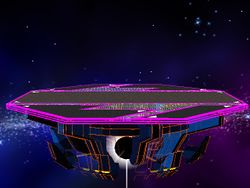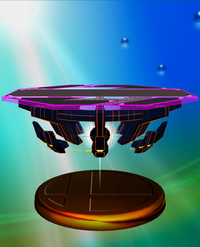Final Destination (SSBM): Difference between revisions
(so yeah after looking at the history I've concluded that the entire section was written in 2006, and that it does not pertain at all to the current state of the game) |
|||
| Line 24: | Line 24: | ||
Final Destination is a flat, medium sized stage. It is octagonal in shape, with a purple outline. There is a floating orb under the platform. While having no effect on gameplay, the background of the stage changes as the platform "flies" through space. The stage starts out in space, but as match progresses, it reaches other areas that have different styles of background. The entire cycle lasts about 216 seconds. | Final Destination is a flat, medium sized stage. It is octagonal in shape, with a purple outline. There is a floating orb under the platform. While having no effect on gameplay, the background of the stage changes as the platform "flies" through space. The stage starts out in space, but as match progresses, it reaches other areas that have different styles of background. The entire cycle lasts about 216 seconds. | ||
== | ==In tournament play== | ||
{{ | Throughout ''Melee''{{'}}s history, Final Destination has always been a legal stage for tournament play, due to its lack of stage hazards and simplistic design that allow for straightforward singles matches. In the modern metagame, it is always one of five starter stages in singles, alongside [[Yoshi's Story]], [[Battlefield]], {{SSB|Dream Land}}, and [[Fountain of Dreams]]. | ||
In the past, there was slight controversy over Final Destination's status as a neutral stage. Detractors argued that the completely flat geometry gives a disproportionate advantage to [[projectile]] users and characters with [[chaingrab]]s, as there are no platforms for opponents to escape to that can allow for alleviation of such pressures. Based on this, they vouched that it should be reserved for counterpicks instead. However, no strategy has been proven to be completely unwinnable on Final Destination compared to other stages, and the advantages that it gives in certain matchups are comparable to other situational advantages that other legal stages offer in different matchups. For example, one can argue that {{SSB|Dream Land}} gives a disproportionate advantage to floaty characters because its very large stage size allows them to survive much longer than they normally would. As such, the majority of professionals and tournament hosts agree that it is a reasonable starter stage. | |||
==Trophy info== | ==Trophy info== | ||
Revision as of 22:35, April 24, 2016
| Final Destination | |
|---|---|
 
| |
| Universe | Super Smash Bros. |
| Appears in | Melee |
| Availability | Unlockable |
| Unlock criteria | Clear all 51 event matches. |
| Tracks available | Final Destination Multi-Man Melee 2 (Alternate) Giga Bowser (When facing Giga Bowser in Adventure Mode) |
Final Destination (終点, Endpoint), sometimes abbreviated as FD or Final D, is a neutral stage in Super Smash Bros. Melee that players often use in tournament battles. It is unlocked by clearing every event match.
In Classic Mode, the player fights Master Hand and Crazy Hand on this stage; in Adventure Mode, Bowser and Giga Bowser; in All-Star Mode, Roy and any of his teammates, and two All-Star Matches, Mewtwo and Ganondorf. Some event matches are also played here.
This stage is very similar to its Smash 64 counterpart, but much larger.
Description
Final Destination is a flat, medium sized stage. It is octagonal in shape, with a purple outline. There is a floating orb under the platform. While having no effect on gameplay, the background of the stage changes as the platform "flies" through space. The stage starts out in space, but as match progresses, it reaches other areas that have different styles of background. The entire cycle lasts about 216 seconds.
In tournament play
Throughout Melee's history, Final Destination has always been a legal stage for tournament play, due to its lack of stage hazards and simplistic design that allow for straightforward singles matches. In the modern metagame, it is always one of five starter stages in singles, alongside Yoshi's Story, Battlefield, Dream Land, and Fountain of Dreams.
In the past, there was slight controversy over Final Destination's status as a neutral stage. Detractors argued that the completely flat geometry gives a disproportionate advantage to projectile users and characters with chaingrabs, as there are no platforms for opponents to escape to that can allow for alleviation of such pressures. Based on this, they vouched that it should be reserved for counterpicks instead. However, no strategy has been proven to be completely unwinnable on Final Destination compared to other stages, and the advantages that it gives in certain matchups are comparable to other situational advantages that other legal stages offer in different matchups. For example, one can argue that Dream Land gives a disproportionate advantage to floaty characters because its very large stage size allows them to survive much longer than they normally would. As such, the majority of professionals and tournament hosts agree that it is a reasonable starter stage.
Trophy info
As time passes on this stage, the level appears to travel through a wormhole from the imaginary Super Smash Bros. Melee world into reality. You move through a cloud-filled sky over a vast mountain range, then into a deep-space vista of dark blues and purples. The scenery is as real as you get in this fantastical world.
Gallery
Trivia
- It is possible to jump under Final Destination with Jigglypuff and Mewtwo. This can also be done by Kirby if he copies Mewtwo's Shadow Ball, and by Peach if she wears a Bunny Hood.
- The track for Final Destination is very similar to Super Smash Bros. 64's Credits theme. This is very evident during the end verse.
- Super Smash Bros. Melee is the only game in which Final Destination is an unlockable stage.
- Final Destination is the only stage of five neutral stages whose stage design is not similar to that of Battlefield's.
| Stages in Super Smash Bros. Melee | |
|---|---|
| Starter stages | Brinstar · Corneria · Fountain of Dreams · Great Bay · Green Greens · Icicle Mountain · Jungle Japes · Kongo Jungle · Mushroom Kingdom · Mute City · Onett · Pokémon Stadium · Princess Peach's Castle · Rainbow Cruise · Temple · Venom · Yoshi's Island · Yoshi's Story |
| Unlockable stages | Battlefield · Big Blue · Brinstar Depths · Final Destination · Flat Zone · Fourside · Mushroom Kingdom II · Poké Floats |
| Dream Land · Kongo Jungle · Yoshi's Island | |









